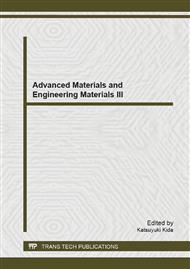p.35
p.39
p.45
p.52
p.56
p.60
p.64
p.69
p.75
Synthesis and Characterization of Hydroxyapatite Powder from Natural Gypsum Rock
Abstract:
This study prepared hydroxyapatite powder that synthesized from natural gypsum rock and find out physicalchemical and cytotoxicity properties. The synthesis realized by reacting natural gypsum powder with 1M of (NH4)2HPO4 solutions using a microwave. Characterizations of natural gypsum powder and hydroxyapatite powder were conducted by XRD, XRF and SEM. In vitro cytotoxicity testings of hydroxyapatite powder were conducted by MTT method using vero cells. XRD patterns of gypsum powder closed to JCPDF 33-0311 (gypsum standard). Characteristics of gypsum powder i.e. contained 41.72% CaO, level of purity 91,6 % and crystal size 7,147 nm. Charateristic of hydroxyapatite powder that synthesized from natural gypsum powder i.e. contained 46.91% CaO and 40.20% P2O5, XRD patern closed to JCPDF 09-432 (hydroxyapatite standard), level of purity 99 % and crystal size 1.243 nm. There were not significantly difference in cytotoxicity properties of hydroxyapatite powder that synthesized from natural gypsum rock and commercial hydroxyapatite powder (p= 0.086). These results indicated hydroxyapatite powder that synthesized from natural gypsum rock possible to be used as bone substitutes.
Info:
Periodical:
Pages:
56-59
Citation:
Online since:
February 2014
Authors:
Keywords:
Price:
Сopyright:
© 2014 Trans Tech Publications Ltd. All Rights Reserved
Share:
Citation:


